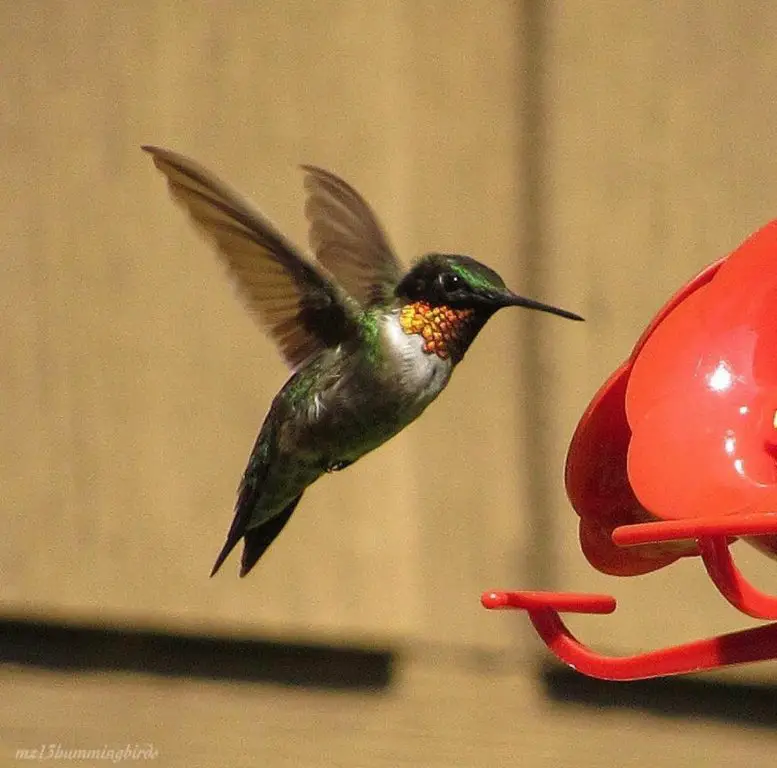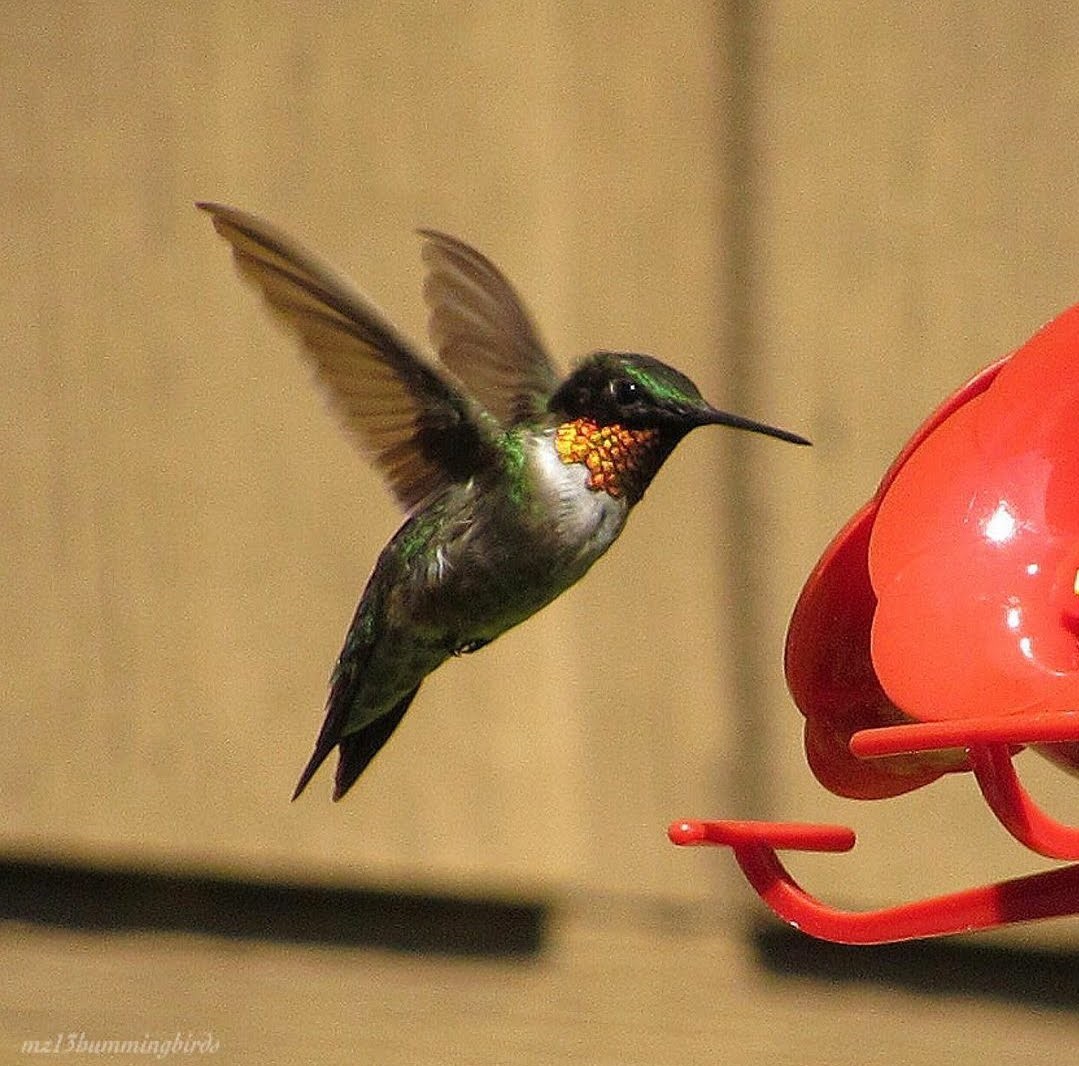This post contains affiliate links.
What species of hummingbirds are found in Michigan?
- There are 6 species of hummingbirds found in Michigan.
- Year-round Natives: Ruby-throated.
- Seasonal: None.
- Rare: Anna’s, Broad-billed, Green-violetears also known as Mexican-violetears, Rufous, White-eared.
Michigan is known as the Great Lake State, since it has the five largest lakes in the United States including Lake Superior, Lake Michigan, Lake Huron, Lake Ontario and Lake Erie. Michigan is home to a multitude of wildlife species including one year-round hummingbird out of the six species listed for this state. The hummingbird season in Michigan peaks during the spring and summer months from April through October.
Michigan is a midwestern state with a humid continental climate. It has warm and humid summers contrasted with cold winters.
There are 3 categories of hummingbirds found in Michigan.
Year-round/Native Hummingbirds
This classification is defined as hummingbirds that reside and do not migrate in Michigan 365 days a year as a group.
- Ruby-throated
Seasonal Hummingbirds
These hummingbirds reside in Michigan temporarily as part of their migratory pattern. A group of these species spend the entire spring, summer and fall in Michigan while others of this migratory group may travel further to northern states during the summer.
- None
Rare/Vagrant Hummingbirds
This classification is defined by hummingbirds residing in a group outside of their normal geographic range. Not only do these species of hummingbirds have a wide variety of specific geographic ranges, they are also known to sometimes interbreed with each other, creating hybrids.
- Anna’s
- Broad-billed
- Green-violetears also known as Mexican-violetears
- Rufous
- White-eared
Note: Hummingbirds are listed in alphabetical order.
Read on to find out more about each of these hummingbird species as well as where and when they can be found in Michigan.
Year-round/Native Hummingbirds
RUBY-THROATED HUMMINGBIRD – (Archilochus colubris)
Conservation Status: Least concerned
Kingdom: Animalia
Phylum: Chordata
Class: Aves
Order: Apodiformes
Family: Trochilidae
Genus: Archilochus
Species: A. colubris
The Ruby-throated hummingbird’s scientific name originated from Carl Linnaeus, a Swedish botanist, who first listed this scientific classification as “Trochilus colubris”. It’s name changed over a hundred years later and was reclassified by Ludwig Reichenbach, a German botanist to “Archilochus colubris”, which is its current scientific name, meaning “top thief” or “sky spirit/sun-god bird”.
Ruby-throated hummingbirds are Year-round Natives and are the most commonly seen hummingbird in Michigan. While most Ruby-throated hummingbirds are seen year round, some Ruby-throated hummingbirds prefer to migrate south to winter in Mexico.
Male Ruby-throated hummingbirds have a striking iridescent blood-red gorget, stopping at the neckline. He is identified with a dull metallic green topside, a light gray underbelly and black wings. The Ruby-throated hummingbird is a smaller species of hummingbirds weighing less than 4.5 grams or 2 U.S. dimes and is 2.8 to 3.3 inches in length. The oldest male Ruby-throated hummingbird has been recorded at 5 years.
Female Ruby-throated hummingbirds have a white throat with some light stippling and are typically larger than the males. The oldest female Ruby-throated hummingbird has been recorded at 9 years, almost double that of the male.
However, the average lifespan of a Ruby-throated hummingbird is approximately 3-5 years.
Juvenile male and female Ruby-throated hummingbirds during their initial stages of life resemble their mother exhibiting a white throat with light stippling.
As the males mature, they begin to display a few specks of color near their neckline and eventually their bolder red throat feathers become more dominant and stately displaying a colorful gorget.
Juvenile females show a light faint grey stippling on their throat. As both sexes mature their less vivid and lighter colored plumage will begin to mature and become darker in color.
Ruby-throated hummingbirds are the only species that breed in Michigan. They are the only ones that nest east of the Mississippi River.
There are two migration routes for the Ruby-throated hummingbird during the spring and fall migrations.
The first migration route is a direct but exhausting nonstop journey southwest over the Gulf of Mexico to Mexico and then down to Central America for the winter. The flight distance over the Gulf of Mexico is over 500 miles. Although this is the direct “short” route, there are numerous obstacles faced by these birds.
Some obstacles include not being able to rest, no means to refuel or eat and having to avoid the dangerous tropical Atlantic hurricanes while flying to their destination. To make matters worse, depending on how you look at it, they migrate during the dark hours of the night or are taking the “Red-eye flight”.
Researchers believe their small size makes the energy expenditure of their grueling trans-oceanic migration journey more taxing for males than for females even though they both double their body’s fat content prior to making the migration across the Gulf of Mexico.
The second migration route is over 2,000 miles, flying along the coastline outlining the Gulf of Mexico. Although this is the “long” route, it allows the opportunity to rest and refuel even though there are less food source guarantees along the way.
Scientists are unclear and continue to investigate as to why one group of birds would prefer to take one route over the other.
The Ruby-throated hummingbirds that prefer to migrate arrive in Michigan at the end of March and the beginning of April during spring migration. Some will begin migrating south for the winter by the middle of October and head towards Mexico and Central America during fall migration. By mid-November, the only hummingbirds seen in Michigan will most likely be the year-round Ruby-throated resident.
Ruby-throated hummingbirds prefer open woodlands and are often seen in parks, gardens, and backyards. These hummingbirds are usually found around feeders in the local gardens. They are solitary birds except during mating periods when they are fiercely territorial and aggressive towards hummingbirds of other species. Even though these hummingbirds have an aggressive side, they can still be eaten by predators such as praying mantises, orb-weaver spiders, dragonflies or large invertebrates.
See pictures of male, female, and juvenile Ruby-throated hummingbirds here…..
Hear sounds of Ruby-throated hummingbirds here…..
Seasonal Hummingbirds
There are no Seasonal hummingbirds species found in Michigan.
Rare/Vagrant Hummingbirds
ANNA’S HUMMINGBIRD – (Calypte anna)
Conservation Status: Least concerned
Kingdom: Animalia
Phylum: Chordata
Class: Aves
Order: Apodiformes
Family: Trochilidae
Genus: Calypte
Species: C. anna
Anna’s hummingbirds are named after Anna Massena, Duchess of Rivoli. These birds are accidental rare vagrants to Michigan since they are a common resident on the western coast.
In 2010, two Anna’s hummingbirds were recorded in Michigan making their appearance to the state less than three times in the last ten years.
Male Anna’s hummingbirds are the only hummingbird species in North America with a red crown. They are identified as mostly green, gray, and magenta in color. The males have a flashy and colorful iridescent magenta gorget and crown. Their size ranges from 3.5 inches to 4.3 inches in length and they weigh 2.4 to 4.5 grams.
The gorget on a male hummingbird is named after the protective metal piece in a suit of armor that covers the wearer’s throat to prevent injury when in battle. Since male hummingbirds are very aggressive with each other when fighting for their own territory, this name is appropriate and fitting to describe their physical attributes.
Unlike many northern temperate hummingbirds, male Anna’s hummingbirds sing during courtship (though the song is so high-pitched and squeaky, it’s hard to call it singing).
Female Anna’s hummingbirds are pale green and are not as colorful as the males. They have an identifiable trait of a distinctive pale white line over each eye.
The Anna’s hummingbird predominantly breeds in northern Baja California and parts of southern California, however due to the transplanting of exotic ornamental plants in residential areas along the Pacific Coast and Inland Deserts, their breeding range has expanded up the Western Seaboard. Anna’s hummingbirds have the northernmost year-round range of any hummingbird species.
The Anna’s hummingbirds protect their territory with elaborate dives targeted towards predatory birds and even towards people they perceive to be threatening.
See pictures of male, female and juvenile Anna’s hummingbirds here…..
Hear sounds of Anna’s hummingbirds here…..
BROAD-BILLED HUMMINGBIRD – (Cynanthus latirostris)
Conservation Status: Least concerned
Kingdom: Animalia
Phylum: Chordata
Class: Aves
Order: Apodiformes
Family: Trochilidae
Genus: Cynanthus
Species: C. latirostris
Broad-billed hummingbirds are an extremely rare vagrant to Michigan since they are primarily located in the southwestern United States, Mexico and Central America. A few remain year-round in the United States, usually very near the Mexican border. In 1996 and 2000 there were only two documented and recorded sightings in Michigan.
Male Broad-billed hummingbirds feature a bright blue-green gorget that spreads back towards its shoulders. Juvenile males show off a full charcoal dark grey body with flecks of metallic blue on their throat and a light green neck and backside. They sport a long beak that is bright orange-red accented with a signature black tip. Their size ranges from 3.25 inches to 4 inches in length and weighs 3-4 grams.
Female Broad-billed hummingbirds are identified with a completely dark bill and a long white accent above the eyes.
Juvenile male and female Broad-billed hummingbirds are both predominantly metallic green on their topside with a white underbelly. Their tails are dark in color and forked.
Broad-billed hummingbird nests are distinguishable because rather than decorate the outside of their nests with lichens, instead choose to construct their nests with outside grass fibers, bits of leaves and bark while using spider webs to glue and hold the nest together. The nest that the female builds hangs on a single long slender branch.
Astonishingly, unlike other hummingbird population counts, the Broad-billed hummingbird has shown an actual general population increase in recent years.
The oldest recorded male Broad-billed hummingbird was 9 years and 1 month old when he was captured and released from a banding operation in Arizona.
See my article: 3 Reasons Why Hummingbirds Are Banded
See pictures of male, female, and juvenile Broad-billed hummingbirds here…..
Hear sounds of Broad-billed hummingbirds here…..
GREEN-VIOLETEARS HUMMINGBIRD – (Colibri thalassinus)
Conservation Status: Least concerned
Kingdom: Animalia
Phylum: Chordata
Class: Aves
Order: Apodiformes
Family: Trochilidae
Genus: Colibri
Species: C. thalassinus / Mexican violetear
The Green-violetears or Mexican-violetears (Violet-ear) hummingbird gets its name from the Latin word thalassinus meaning “color of the sea”.
They are a rare and accidental hummingbird to Michigan because they are predominantly a resident of Mexico and Central America.
Male Green-violetear hummingbirds are iridescent green in color with a show of bright violet ear patches on each side of their neck (hence the name “violet-ears”). The tail of this hummingbird is metallic blue-green with bronze central tail feathers that feature a black band underneath. Their size ranges from 3.8 inches to 4.7 inches in length and they weigh 5-6 grams.
These species of hummingbirds are found on the edge of cloud forests from Mexico to Nicaragua where they enjoy a high level of tropical humidity in their environment. This dark hummingbird is commonly seen in forest edges and clearings.
Green-violetear hummingbirds are somewhat nomadic. Scientists do not know much about their migration patterns as they have not been well-studied. Of the data that has been collected, the Mexican Violetear is typically found in central Mexico, central America, and northern South America.
Recently, there have been some seasonal movements observed as individual Mexican-violetears have wandered north into the United States and have been identified as straying as far north as Wisconsin, Michigan, and even as far north as Canada.
Like many other kinds of hummingbirds, the Green-violetears hummingbird is a solitary nester. They forage for nectar and insects alone rather than in a flock, but groups of these hummingbirds can be seen around flowering trees, such as the coffee-shade Inga tree.
See pictures and hear sounds of Mexican violet-ear hummingbirds here…..
RUFOUS HUMMINGBIRD – (Selasphorus rufus)
Conservation Status: Near threatened
Kingdom: Animalia
Phylum: Chordata
Class: Aves
Order: Apodiformes
Family: Trochilidae
Genus: Selasphorus
Species: S. rufous
The Rufous hummingbird gets its name from the Latin word rubrum meaning “red” that is used to describe its reddish-brown coloring. They are a Rare/Vagrant and when sighted is usually during the fall and winter season at the end of the year.
Even though Rufous hummingbirds are considered a migrating bird and are sighted more frequently than Anna’s hummingbirds in Michigan they are still considered a rare species since they have only been recorded 20 times in the last two decades.
Male Rufous hummingbirds display an iridescent orange-red gorget with rusty-colored flanks and tail. They have a white to beige underbelly and a black bill. Males can also have green plumage with specks of green color on their rustic looking backs or on the crown of their head along with chocolate brown dorsal feathers. Their size is 2.8 inches to 3.5 inches in length and weigh 3.2 grams.
Juvenile male Rufous hummingbirds have a rustic look with small iridescent orange specks of color on their throats.
Female Rufous hummingbirds are green and white with some iridescent orange feathers on their throat. Their tail is dark with white tips and an orange-red base. Female Rufous hummingbirds are slightly larger than the males in anticipation of producing offspring.
They have one of the northernmost breeding ranges of any hummingbird in the world; migrating north from Mexico to Oregon, Washington, Canada and nesting as far north as Alaska to breed during the summer months. They are polygamous and will mate with several partners in a season.
Rufous hummingbirds make the longest migrations of any bird in the world. They travel making a clockwise circuit of western America every year that is approximately 3,900 miles.
Rufous hummingbirds are highly territorial and aggressive towards other hummingbirds and animals. They are fearless and have a reputation for chasing away not only other hummingbirds but even large birds and rodents from their favorite feeders. They have been known to even attack squirrels and chipmunks that come too close to their nest.
Their flying acrobatic skills can outmaneuver all other hummingbird species, making them extremely competitive at feeders.
Rufous hummingbirds have excellent memories and have been known to investigate the location of an old hummingbird feeder years after the feeder has been removed.
During a capture and release banding operation in British Columbia, the oldest living recorded female Rufous hummingbird was 8 years and 11 months old.
See my article: 3 Reasons Why Hummingbirds Are Banded
Due to habitat loss in the Pacific Northwest, Rufous hummingbirds are listed at “near threatened” status by the IUCN red list of threatened species.
See pictures of male, female and juvenile Rufous hummingbirds here…..
Hear sounds of Rufous hummingbirds here…..
WHITE-EARED HUMMINGBIRD – (Hylocharis leucotis)
Conservation Status: Least concerned
Kingdom: Animalia
Phylum: Chordata
Class: Aves
Order: Apodiformes
Family: Trochilidae
Genus: Hylocharis
Species: H. leucotis
The White-eared hummingbird’s scientific name is Basilinna leucotis, but its higher classification name that most people use is Hylocharis leucotis which is a combination of the genus name Hylocharis and species name Leucotis.
The White-eared hummingbird gets its scientific name from the Latin word (hylo) “wood or matter,” (charis) derived from a Greek word meaning goddesses of beauty and grace; (leuco) in Latin means “white or without color” and (otis) meaning “ear”.
White-eared hummingbirds are accidental vagrants to Michigan since they are a common resident of Mexico and Nicaragua. Only one documentation in 2005 has been recorded.
Adult male White-eared hummingbirds have a spectrum of green colors on their back ranging from a Granny Smith apple green to dark emerald with patches of iridescent turquoise on their throats. In darker lighting, their crown and throat can appear black. They possess a distinct and noticeable white stripe that spans from the eye to the neck. Their bill is shorter than the average hummingbird bill and is half red and black. Their size ranges from 3.5 inches to 3.9 inches in length and weighs 3-4 grams.
See pictures and hear sounds of White-eared hummingbirds here…..
Happy Hummingbird Watching!

Backyard Visitors participates in affiliate programs which compensate us for referring traffic.


